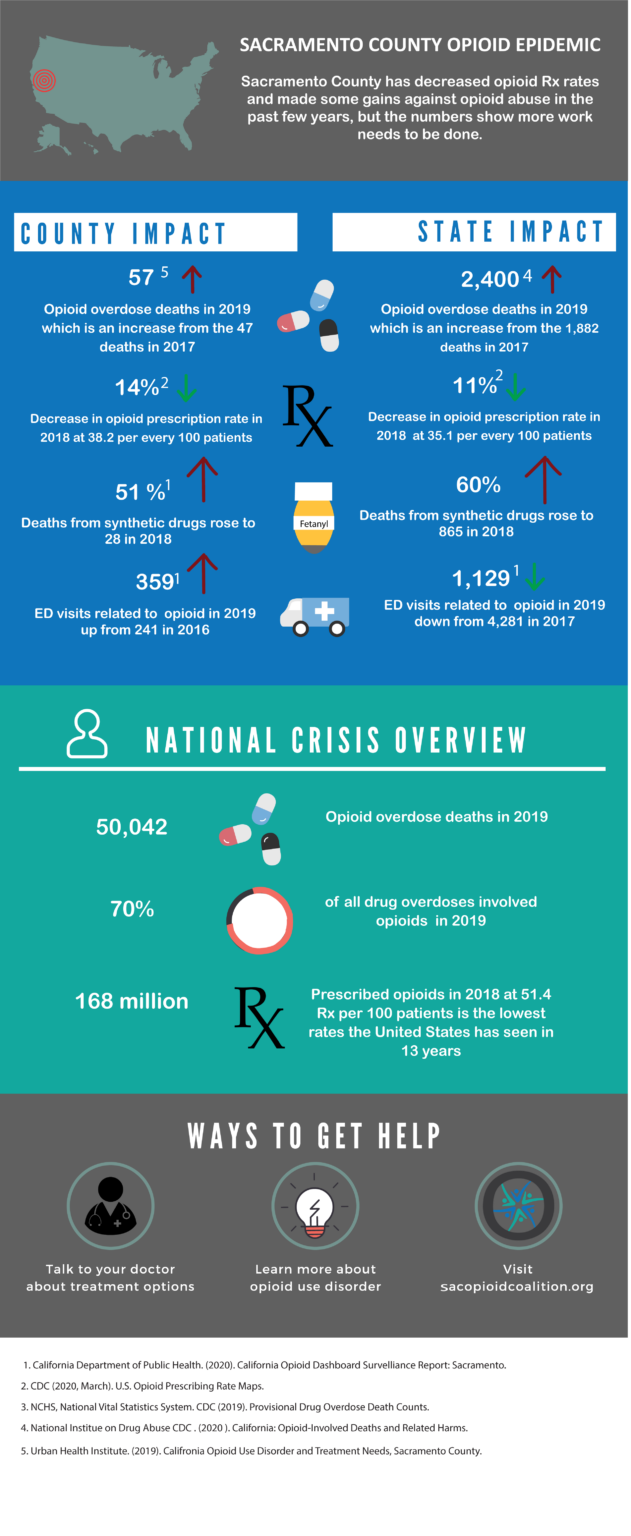Opioid Data
We are dedicated to reducing opioid overdose deaths in Sacramento County and El Dorado and Yolo. To truly understand the best plan of action, we must understand the history and current status of opioids in our community.
The Opioid Epidemic in Sacramento County affects everyone in the community. It will take people from all parts of our community to stop opioid overdose deaths. Looking at the data, monitor our progress and make our action plans.
The Sacramento County Opioid Coalition started in 2015 after the release of the Sacramento County Opioid Prescription Drug Monitoring Surveillance Report. Now, the data shows us that some progress has been made. We still have a lot of work to do. Recent findings have shown an increase in deaths while prescription rates have gone down. Synthetic opioids like Fentanyl are causing an increased number of deaths.
We get local data from the California Opioid Overdose Surveillance Dashboard. There, every county in CA can get specific data. Our data shows us that we have to continue what we are doing and adapt to solve the new problems.








Resources for Data on Sacramento County
California Opioid Overdose Surveillance Dashboard, California Department of Public Health
CDPH Substance and Addiction Prevention Branch (SAPB) Death data. These counts may not represent all overdose-related deaths that occurred during the corresponding period.
Sacramento County 2020 Snapshot
El Dorado County 2020 Snapshot
The State-wide and County-specific dashboards and data available through this application are the result of ongoing collaboration between the California Department of Public Health (CDPH), Office of Statewide Health Planning and Development (OSHPD), Department of Justice (DOJ), and the California Health Care Foundation. The goal is to provide a data tool with enhanced visualization and integration of statewide and geographically-specific non-fatal and fatal opioid-involved overdose and opioid prescription data.
2019 California County Fact Sheets: Treatment Gaps in Opioid-Agonist Medication Assisted Therapy (OA-MAT) and Estimates of How Many Additional Prescribers Are Needed, Urban Health Institute
U.S. County Prescribing Rate Maps, CDC
ESRI: Mapping American Communities
This site uses color coded United States maps that highlight state and community hot spots for overdoses and increased opioid prescribing patterns, and tracks emerging use patterns. See how your state/community compares to other areas.
National Survey on Drug Use, SAMHSA
This data dashboard from this website created by the California Department of Health Care Services (DHCS) has created this website to offer vaulable local information on opiods.
Sacramento Opioid Prescription Drug Monitoring Report 2015, Sacramento County Epidemiology Unit
This report lead to the start of the Sacramento County Opioid Coalition because the data showed the need for it. The report identifies risk factors of prescription opioid misuse in Sacramento County. The data source for the report is the California Department of Justice (DOJ) prescription drug monitoring program (PDMP), known as the Controlled Substance Utilization Review and Evaluation System (CURES). Indicators of potential misuse of opioid prescriptions used in this report were adapted from indicator lists developed by the Centers for Disease Control and Prevention (CDC) and the Brandeis University Center for Excellence.
Be Healthy Sacramento, Sacramento County
This includes two Opioid Prescription Indicators, available at the patient zip code level: 1) Percentage of population that is an opioid prescription patient, and 2) the rate of prescriptions of opioid drugs in patient’s local per 10,000 population. Several other health indicators can be found on this website.
CDPH EpiCenter Alcohol and Other Drug (AOD) Health Consequences Query System, California Department of Public Health
This query system includes data on the health consequences (deaths, hospitalizations, and emergency department visits) of substances with potential to cause substance use disorders.
More About the Science of Opioids
Treatment Approaches for Drug Addiction, National Institute on Drug Abuse
Opioid Use Disorders, National Council for Behavioral Health
Science of Addiction, John Hopkins School of Opioids
What Science Tells Us About Opioid Abuse Addiction, National Institute on Drug Abuse
The Surgeon General Spotlight on Opioids, U.S. Department of Health & Human Services
America’s Drug Overdose Epidemic: Putting Data to Action, CDC
Opioid Crisis, Health Resources and Services Administration
National Data Resources
National Center For Health Statistics, CDC
This data visualization presents provisional counts for drug overdose deaths based on a current flow of mortality data in the National Vital Statistics System.
ESRI Opioids Epidemic Map of Prescriptions
A geographic view of opioid prescriptions made in the United States is helpful to understanding how counties and ZIP codes compare to each other, their state, and the nation as a whole.
CDC’s Wide-ranging Online Data for Epidemiologic Research (WONDER)
CDC Wide-ranging Online Data for Epidemiologic Research (CDC WONDER) is a public resource. This application makes many health-related data sets available to CDC staff, public health departments, researchers, and others. The data help with public health research, decision making, priority setting, program evaluation, and resource allocation.
CDC’s Web-based Injury Statistics Query and Reporting System (WISQARS™)
CDC’s WISQARS™ is an interactive, online database that provides fatal and nonfatal injury, violent death, and cost of injury data. Researchers, the media, public health professionals, and the public can use WISQARS™ data to learn more about the public health and economic burden associated with unintentional and violence-related injury in the United States.


